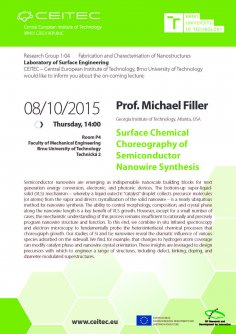Speaker: Prof. Michael Filler from Georgia Institute of Technology, Atlanta, USA
Semiconductor nanowires are emerging as indispensable nanoscale building blocks for next generation energy conversion, electronic, and photonic devices. The bottom-up vapor-liquid-solid (VLS) mechanism – whereby a liquid eutectic “catalyst” droplet collects precursor molecules (or atoms) from the vapor and directs crystallization of the solid nanowire – is a nearly ubiquitous method for nanowire synthesis. The ability to control morphology, composition, and crystal phase along the nanowire length is a key benefi t of VLS growth. However, except for a small number of cases, the mechanistic understanding of this process remains insuffi cient to rationally and precisely program nanowire structure and function. To this end, we combine in situ infrared spectroscopy and electron microscopy to fundamentally probe the heterointerfacial chemical processes that choreograph growth. Our studies of Si and Ge nanowires reveal the dramatic infl uence of various species adsorbed on the sidewall. We fi nd, for example, that changes to hydrogen atom coverage can modify catalyst phase and nanowire crystal orientation. These insights are leveraged to design precursors with which to engineer a range of structures, including defect, kinking, doping, and diameter-modulated superstructures.








